|
"Dope Can" was a monthly roundup of aeromodeler news and views which ran in
American Modeler magazine (which was re-named American Aircraft Modeler
in 1968). This March 1961 edition covered a lot of ground, as did all Dope Can columns.
A "Hummin' Boid" towline-launch R/C glider with a 9-foot wingspan took the "My Favorite
Model" photo prize for the month. Well known in control line circles (pun intended)
Hi Johnson has a new stunter design he dubbed "Stunt Supreme." Then, there's the
0.006 cubic inch displacement Hummingbird diesel engine - claims to be the
world's smallest, and I believe it. The Jacksonville "Prop Kickers," incredibly
still in existence today, was endowed with the "Club of the Month" honor. A big
deal is made of the action photo on the magazine cover. Remember that back in the
day, there were no microprocessor-controlled, auto-focusing, light-level-setting
lenses and irises that could make a rank amateur's photos look like a seasoned professional's,
so a lot of planning and test runs were required. Your image stabilizing smartphone
can easily get photos as good or better than any commercial cameras in the 1960s.
We have things really easy today, for sure. Finally a few new land speed records
were set with model cars. It's all good.
Dope Can
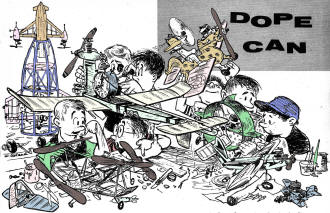 We're not quite sure how many power plants
Roland has drawn into that mad, mad round-the-Dope-Can scene there above, but at
last count it was up to 15. Can you spot them all? We're not quite sure how many power plants
Roland has drawn into that mad, mad round-the-Dope-Can scene there above, but at
last count it was up to 15. Can you spot them all?

Fourteen year old Gailla poses with her Dad's 9 foot Boid, his
favorite model.
His Favorite Model
The only plane he has in his possession after 25 years of building free flight,
radio control and glider craft is a "Hummin' Boid" tow-line-R/C glider laments Charles
Cortright of Phillipsburg, N. J. For over 25 years Charlie dreamed of building a
big glider model, having seen a 9' span job at a model club meeting when he was
10 years old.
This one, exactly to the A.M.-Hobby Helper plans, is colored orange with light
blue trim. CC's 14-year-old daughter Gailla is holding the glider in the photo.
Charlie gets our monthly $25 my-favorite-model prize check.
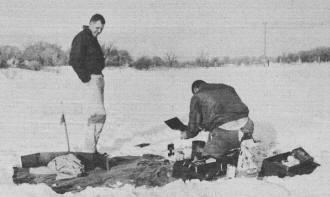
Snow operations in balmy Des Moines is caught by R. F. Watson
and his trusty camera. Darrell Bobzin looks on as Dean Swift warms engine over "furnace."
Note the "southern exposure" as Dean kneels down. Brr-r-r-r-r-! When pix was taken
by Watson in Des Moines' Ewing Park the temperature was 25 degrees, wind 5 mph.
Sno-Fun in Des Moines
R. F. Watson has provided us with a chilly glimpse of what it takes to go free
flight flying in January in Iowa: planes, modelers, usual free flight equipment
- plus extra clothes, blankets, galoshes, 5-qt can "furnace," charcoal, and lots
of fortitude (or, is it no brains?).
Anyhoo, Darrell Bobzin and Dean Swift show you how it's done. You punch holes
in the bottom of the 5-qt can, fill with charcoal, saturate with fuel, stand back,
toss in match, Varoom-m-m, when things simmer down some you huddle around the "furnace"
until your motors and fingers get warm, then you're ready to fly. At least every
landing is a soft landing, except you have to dry out your powerplant each time.
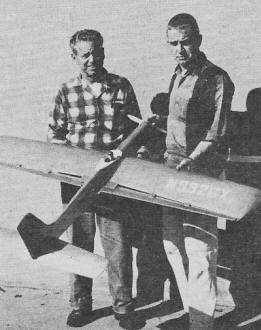
"Stunt Supreme" is latest aerobatic design by Hi Johnson, features
counterbalanced flaps; spans 5 feet.
Swept Stunter
At a Los Angeles Sky Wolves contest Hi Johnson and Bob Beach introduced a new
swept-wing control line aerobatic stunt plane. Herb Partridge has supplied a photo
of same. Designed by Johnson, the plane is a radical departure from normal stunt
types. It is completely symmetrical-wing, stab and thrust line are all on the same
line. The lead-out wires are not swept back, no offset is used in the engine, both
wing panels are the same size.
Unique flaps are aerodynamically counterbalanced 24% ahead of their hinge line.
Plane is big; span is 60" with 670 sq. in. area, 44-1/2" overall length. It is named
"Stunt Supreme" to match Hi's latest stunt engine.
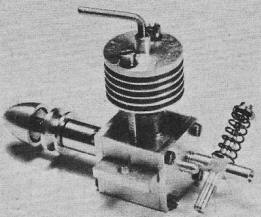
Tiny production "diesel" is machined completely from solid stock.
Dragonfly has .012 c.i. displacement.
Tiny Motor, Indeed
Smallest production engine in the model world is said to be the little-known
Dragonfly made in England. Comes in two sizes: .006 and .012 cubic inch displacement.
Photo shows the larger version. Unusual features include a rotary disc intake valve
and a 2-piece piston with the wrist-pin carried in an aluminum yoke. Engines are
machined entirely from solid stock, no castings are used.
Club of the Month
Step right up and meet a grand gang of modelers from Jacksonville, Ill. The Propkickers
have been organized for 15 years, but it was not until 1958 that they secured a
permanent place to fly. We'll let Paul Smith. (1000 N. Church St.) tell you their
story ...
"After 13 years of flying in any place we could find, we encountered a fellow
who could and did help us; he is the manager of our local airport, Carmen P. Burgard.
He has been a real friend to our model club.
"Through Mr. Burgard's efforts the airport authority set aside a place for our
'Model Airport.' We are behind a Cyclone fence, which controls the spectators, and
helps protect us and our equipment. There is plenty of parking space just outside
the fence, so everybody can watch the activity without leaving their cars if they
wish (drive-in modeling!). We now have three control circles with space for more,
and. each member has a ten foot square pit area with his name on a metal tag attached
to the fence.
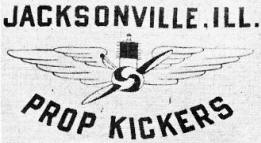
Club-of-the-month met sympathetic airport manager; result, permanent
model flying site.
"The Propkickers are mostly U-control flyers, although we have some free flighters
and radio controllers. We conduct a business meeting once a month at the airport's
instructors office. Last year we joined the A.M.A. and now have close to 50 members.
Club flying is on Sundays and Wednesday evenings, although the field is open to
members any time they care to use it. You have to be an A.M.A. licensee to fly on
our field due to airport regulations.
"We try to have a club competition at least once a month - rat racing, combat,
stunt; we are now working up to Thompson Trophy racing. We have about 30 TT racers
ready to go. Our flying weather is very bad here in the winter months, so that is
when we do our building. We have special auctions where club members bring and donate
items, and the money goes into the club treasury. This serves to keep our dues low
and build up our contest fund.
"The club constructed a U-control trainer and we use it to teach new members
how to fly; this saves a lot of unnecessary crack-ups for the beginner. We have
an attendance prize and refreshments on meeting nights to boost turnouts during
the winter months.
"Our Propkickers all feel that modeling is an easy way for grown-ups to help
young fellows do something that is fun, constructive, and keeps them out of trouble
at the same time. We have several father and son teams in our group, and one family
of flyers - father, mother, son and daughter. We also have city and county police
who are members."
Paul, your outfit sounds like a real live-wire gang. Let's hope others can profit
from your example. Our monthly $10 club emblem award is on its way to you.
Speaking of Club Emblems
We have a great many on hand here at magazine headquarters, but since we present
only one a month, many are what we consider "out of date." Club personnel changes
so rapidly we'd like to be updated on all organizations whose emblem have not yet
been presented in these pages. Send along a typed report on your current activities
together with a copy of the club's emblem. We pay $10 for each one published. Nuff
said?
Cover Action Photo
How do you like that cover color photography this issue? It was a lot harder
to shoot than you might believe. We are indebted to Richard Crandall for data on
how it was made.
Most of the photographers at Boulevard Photographers, Inc., of Detroit, are enthusiastic
R/C fliers. One day in August Jim Northmore, Duane Fouraker and John Wisner went
to Cass Lake where they combined the thrills of two sports by hydro-flying R/C from
Jim's speedboat. As it happened, John Wisner had his camera with him and he took
advantage of the picture possibilities - he felt that the results could be different,
interesting and full of action. John made the cover picture while standing hip-deep
in water as the boat sped by at 15 mph. Wisner also had several technical problems
to cope with ...
1) The action of the picture had to be stopped by using a fast shutter speed
and "panning" the moving boat with the camera.
2) The driver of the boat had to make "passes" at a predetermined distance from
the photographer to allow pre-focusing of the camera.
3) The photographer had to quickly protect the camera from the boat's wake after
the picture was exposed.
4) Both boat occupants had to look happy, interested and realistic.
5) The model plane had to be held in the proper position for launching.
The plane, a deBolt Champion, powered by a Veco 19, equipped with scaled-up "Edo"
floats and a sub-rudder for stability, uses eight-channel Min-X R/C equipment. Duane
Fouraker is doing the launching and his pretty companion is Peggy Tabor. The camera
used was a 4x5 Graflex; the film Anscochrome; the shutter speed 1/100 sec.
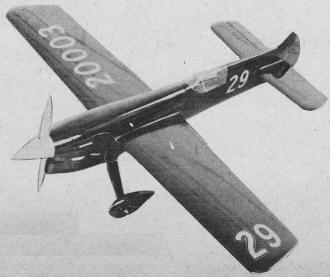
Proto speed racer by Jim DeWesse has slick lines. Question now
is: how does she perform?
Looks Plus Speed?
Why not a proto speed job that looks like an actual prototype racer mused James
P. DeWesse. So he got busy and the photo we show is the end result. Jim says he
was seeking a design which would incorporate some of the lines of such great Thompson
Trophy racers as Turner's Pesco Special, Kling's Folkerts and the Keith Rider jobs.
DeWesse's design is named the S. J. Special, uses inverted Super Tigre 29 for power.
Wing area is 127 sq. in. Finish is Aero Gloss black. No performance specs so far,
but a mighty nice looking creation, JPDeW!
Dihedral Correction!
No sooner had our January issue appeared than a frantic message floated in from
Salt Lake City and Terry Thorkildsen, designer of the "Lil Goliath" PAA-Load plane.
For once we can't blame the printer for the error; seems it slipped by Terry when
he had rough pencil plans prepared for AM's draftsman.
Dihedral, as in the sketch, for the center panels should be 1/2" instead of the
1-1/2" shown in January. Tip dihedral measurement of 3-1/2" remains correct.
Said TT, "The way the dihedral was shown on the plans, it would make Lil Goliath
even more stable, but it wouldn't have as good a glide ... the plane is quite stable
to begin with!"
Okay, men, let's get all the copies corrected; if you know of someone building
this design please pass along the change to him. Maybe it would be a good idea to
broadcast the info at your next club meeting. We thank you, Terry thanks you, Pan
Am thanks you!
Meet the Authors
Interesting collection of contributors this issue. Step up and say hello to the
gang. Let's start with ...
Leonard King of Waldwick, N. J. Len is responsible for the single channel, rudder-only
"So-Lo" and a mighty consistent flyer it is, too. The craft has been duplicated
by many members of the North Jersey Radio Control Club of which Len is president.
King started modeling in 1936 at the age of 12. He owns and operates King Electronics,
a TV service and sales center. He is a graduate of the Paterson Radio Institute.
Frank Willard Beatty
Credit Frank for that fine Howard "Ike" control line caler. Frank was born
and educated in EStL, he is a gas plant refinery operator with Socony Mobil, and
a member of his hometown Prop Benders club. Beatty began building via Megow solids
and rubber powered scale job back in the early Thirties. His published design projects
include a Fokker D.III, R. E. 8, Travel Air 2000, Curtiss R-6 Racer and Ryan PT-22.
Paul Kaitukoff of Riverside, Calif. Half of the Texan-FAI-Ton team, Paul caught
the modeling bug at the age of 11 in 1937. He is vice president of the potent Max-Men
club of Southern California; was born in San Francisco. Kaitukoff is a loftsman
with Rohr Aircraft. Three views of his FAI-Ton appeared in our November 1959 issue.
Ed Miller of Pomona, Calif. Ed is another true son of the West having got his
start in life in Hanford, Calif. He is a school teacher (sheet metal, etc.), was
graduated from Fresno State Teachers College. While his collaborator Kaitukoff was
serving in the Navy, Ed was in the U. S. Army artillery service. Miller is president
of the Max-Men and FFMA-AOSC veep (Free Flight Model Airplane Association of Southern
California). His "Texan" design appeared in our January 1960 issue. As most readers
must be aware Ed was a member of the U. S. FAI Power team and flew at Cranford,
England, last year. He has numerous big contest firsts, including Nats victories.
Like Paul Miller also started modeling in 1937 when he was 12.
Traveling Exhibit
Jim Preston of the J&J Hobbyhouse has created a traveling display of plane
kits and accessories which he will exhibit at model meets in these states: Ohio,
Indiana, Pennsylvania, Michigan, Kentucky and West Virginia. This is on a first-come,
first-served basis so contest directors should place requests with Jim as soon as
possible .
Says Preston, "This display exhibits airplane kits and related items manufactured
by various people in the hobby business. We are representatives of these firms,
this may be verified by checking directly with them if anyone so desires. We will
have nothing for sale, merely a presentation of new and interesting merchandise
and free literature for the modelers. Among the manufacturers cooperating in this
program are K&B, deBolt, Sterling, Cleveland, Ambroid, to mention a few."
Car Gang Reports
Robert L. Stevenson, secretary of the National Mite Race Car Association, sends
along results of NMRCA's national races. 29 Custom Class, R. Daluga, 119.36 mph
for a new record; 19 Custom, J. Carlson, 98.90; IS Custom, H. S. Briggs, 87.21;
099 Custom, Briggs, 78.83, new record; 19 Stock D. Dawley, 67.97.
All the "29" cars were powered by Dooling 29's; the 19's by McCoy, Hornet, and
one Super Tigre (3rd). Bob reports that there are cars and parts available to anyone
interested in the model race car activity. You can reach him at Bobby's Hobbys,
16310 Plymouth Rd., Detroit 27, Mich.
Annudder Win
Seems they never stop! Dave Hemstrought of Mullins, S. C., designer of that fine
stunting PT-19 which appeared as a construction article in A.M. passes along word
that his model won the Open class stunt crown at the Southeastern Championships
held in Anderson, S. C.
That's the ole fighting spirit, D.H.
Wow! And A Series of "My, My's"! Tulsa Glue Dobbers' newsletter reports that
Bill Netzeband, new club proxy and author of the C/Line Nats story in this issue,
found his new Fox Combat Special turns 19,000 in the air on an 8-7 prop. As they
say - Man, that's like fast.
Double "Wow" and A Series of "WAM's"! We are absolutely and but completely overwhelmed
with the annual report of the Western Associated Modelers compiled by Mrs. Myrtle
"Mom" Robbers, W.A.M. secretary-treasurer. What a rip-snortin,' razzle-dazzle outfit!
The compilation lists 103 member clubs (from Aerial Robots to Yellow Jackets);
69 of these clubs participated in control line meets. Biggest C/Line contest attracted
224 flyers to Richmond; most models were entered at a Berkeley competition, 412.
Average WAM U-control fray drew 166 flyers, 272 planes.
Major interest centered around the following categories: 1) Stunt, 929 entries
during the year, with a 22.6% activity factor; 2) Speed, 913, 22.4%; 3) Combat,
718; 17.6%; 4) Ten-Mile, 346, 8.5%; 5) Carrier, 293, 7.2%; 6) Scale, 199, 4.9%;
7) Proto Speed, 156, 3.8%; 8) Jet Speed, 105, 2.6%, and so on.
Fifty. (count 'em!) champions were designated. Tops were Ernie Miller, Concord
Circle Burners, overall C/Line flyer; Dorothy Kolb, Castro Valley Flying Clowns,
overall women's champ; Lyman Armstrong, Twin Cities MAC, overall free flight champ;
and Sandra Alessi, women's stunt champ.
Mom lists 45 perpetual and special trophies. Special honors went to the following
groups: Gridley Air Lords for Ten Mile, Combat and "most beginners" as well as "most
advanced" club points; Castro Valley Flying Clowns, scale, speed and achievement
points; Concord Circle Burners, most expert points; San Bruno Aerobats, stunt points;
Flying Acorns, most carrier activity.
In the 1960 WAM Annual State Meet run off at Berkeley last September most contestants
were in the 10 to 20-year-old bracket. Mrs. Robbers points out that 50% of all WAM
flyers are teenagers. California, here we come!
What Is "Hopkit?"
According to its designer, Bob Demitz of National Engineering Associates it's
an inexpensive mechanism that adds extra pep to front rotary valve engine (the ones
that have the carburetor up front) by providing another carb with an added rotary
valve. Dual carburetion means more air and more fuel, says R.S.D.
Hopkit is available in three "Marks": No. 1 for K&B 29 and 35, Fox 29 and
35 with 4-hole backplates, McCoy 29 and 35, $1.95; No.2 works with a Bramco or K&B
throttle carb, $1.29; No. 3 is kit of parts which makes up into No. 1 or 2, 99c.
Additional details from N.E.A. at address shown.
Getting More Beginners
In an effort to generate more flying activity on the part of younger model builders
and get more youngsters active in air-modeling American Modeler asked activity and
industry leaders for suggestions. A tremendous number of replies have been received;
many of these are so detailed that it is not possible to present them in their entirety.
But the editors have permitted us to offer some of the ideas here. We hope these
responses, briefed as they may be, will stimulate discussion and action among clubs
and activity directors.
Tom Sutor, Coral Gables, Fla. Mr. Sutor is chairman of the King Orange International
meet held in Miami each New Year's weekend. He is a transport pilot and a staunch
supporter of model aviation.
"Like the old adage 'there is no substitute for hard work!' It is going to take
real work on the part of all of us who are interested in model aviation to get youngsters
active.
Change in dihedral directions for Terry Thorkildsen's "Lil Goliath" PAA-Load
winner and record-setter (from January 1961, A.M.) gives figures shown above.
"One - Cash is needed. 2 - Hobby shops must be aware of their responsibility.
3 - The major industries must be aware of their responsibility. 4 - The community
must be aware of its responsibility. 5 - If it is possible to line up the above,
then institute a model building and flying program in the public schools. I am sure
you are aware that the above will take organizational ability, hard work and cash."
Earl Smith, Wakefield, Mass. Mr. Smith is General Manager of the Paul K. Guillow
kit manufacturing firm, and a long time worker for modeling.
"What is needed is the cooperation of those who don't necessarily stand to profit
from a modeling program. Examples of this type of assistance are readily at hand
- the leaders of the Cub and Boy Scouts who are more interested in seeing that their
charges have a 'growth program' rather than deriving a personal gain from the activity."
Duke Fox, Ft. Smith, Ark. Mr. Fox who heads up the Fox engine producing concern
is a former modeler.
"Young people want attention and - they will do the things which get them attention
and praise. A model shop operator in the past gave time-consuming attention to his
younger clientele, coaching and praising and helping them to build and fly. There
is no substitute for this."
More Ideas Next Issue
This discussion will be continued with contributions from many noted leaders.
We'd like to have your comments, too!
Posted August 16, 2021
|